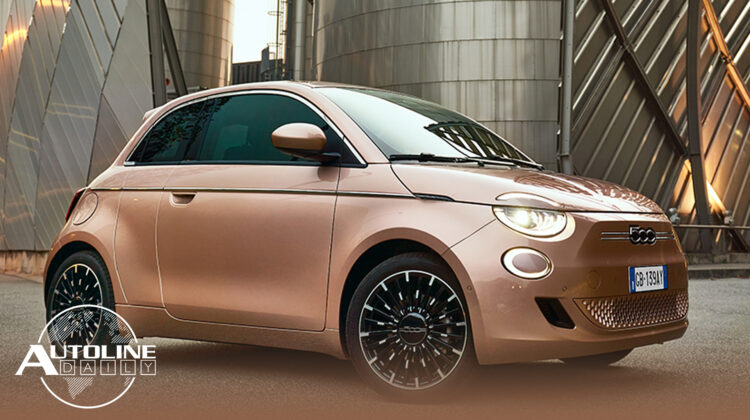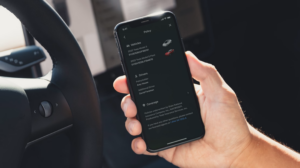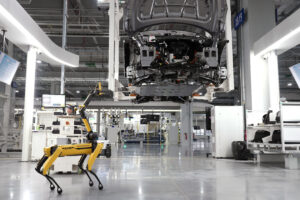

Follow us on social media:
Runtime: 11:08
0:00 Europe EV Sales Resume Strong Growth
1:29 Sales of PHEVs Take Off in China
2:34 Nissan Raising U.S. Hourly Wages
3:15 Tesla Insurance Runs Into Problems
4:48 NIO & Changan Team Up on Battery Swapping
5:37 CATL & Stellantis to Build EU Battery Plant
6:06 Hyundai Using Robot Dogs to Help Build Cars
7:42 Ford Dealers Push Back on EV Requirements
8:26 Toyota Fined for Financial Misconduct
Visit our sponsors to thank them for their support of Autoline Daily: Bridgestone, BorgWarner, Intrepid Control Systems, Schaeffler and Teijin.
This is Autoline Daily, the show dedicated to enthusiasts of the global automotive industry.
EUROPE EV SALES RESUME STRONG GROWTH
For a while it looked like sales of electric vehicles were slowing down in Europe. Not anymore. The European Automobile Manufcaturer’s Association, better known as the ACEA, reports that last month, registrations of EVs shot up more than 36% to more than 121,000 vehicles. Through the first 10 months of the year Europeans bought 1.2 million EVs, up 53% from last year. EVs now have 14% market share, surpassing diesel’s market share for the first time. But hybrids did even better. Their sales shot up more than 38% in October. Europeans bought 2.2 million hybrids through the first 10 months, and they now account for 28.6% of the market. However, plug-in hybrids haven’t done as well. Sales fell 5% last month and they lost two points of market share now down to only 8.4%. Sales of gasoline cars grew 8% but that was lower than the overall growth in the market, so they lost two points of share as well. And so the European market has hit a historical inflection point. Over half the market now comes from sales of EVs, hybrids and plug-ins.
| EU Market Share October, 2023 |
|
|---|---|
| Gas | 33.4% |
| HEV | 28.6% |
| BEV | 14.2% |
| Diesel | 12.0% |
| PHEV | 8.4% |
| Other | 3.4% |
SALES OF PHEVS TAKE OFF IN CHINA
But in China, there’s a different story going on. Sales of hybrids are falling fast, while sales of plug-in hybrids are soaring. According to the China Association of Automobile Manufacturers, sales of PHEVs were up 72% for the first 9 months of the year, while sales of hybrids were down 15%. And while the total numbers are still low, sales of extended range EVs shot up 157%. So sales of PHEVs and EREVs are growing faster than sales of pure electrics. EV sales are up 14% this year, but PHEVs and EREVs are up 85% combined. By the way, Reuters reports that BYD has 8 of the top 10 selling PHEVs in China. And it points out that BYD is exporting PHEVs to South America, where there isn’t much of a charging infrastructure. It’s fascinating to see sales of plug-in hybrids growing so fast in China, and that’s a trend we’re going to have to keep an eye on.
| China Market Share Jan-Sept, 2023 |
|
|---|---|
| ICE | 62.3% |
| BEV | 22.9% |
| PHEV | 8.9% |
| HEV | 3.4% |
| EREV | 2.5% |
NISSAN TO RAISE U.S. HOURLY WAGES
Now it’s Nissan’s turn. It’s following Toyota, Honda, Hyundai and Subaru to boost wages for its non-union factory workers in the U.S. Nissan will give them 10% raises in January. Nissan says it’s also eliminating wage tiers. It looks like all the non-union automakers in the U.S. are boosting wages in response to the record deal the UAW signed with the Detroit automakers. Obviously, they want to keep the union out of their plants. But organizing them is now the UAW’s top priority, something it hasn’t succeeded in doing after 40 years of trying.
TESLA INSURANCE GETS THUMBS DOWN
Is Tesla growing too fast for its own good? In 2019 the EV maker launched its own insurance company, Tesla Insurance, because it believed it could offer customers a better service. Other insurance providers at the time were charging much higher rates for EVs, mostly over concerns of high repair costs. So, Tesla Insurance came out and undercut most of their prices. But Reuters reports that understaffing issues have led to a number of complaints, including not being able to get ahold of anyone, having to make multiple callbacks, and having to wait weeks or even months to get paid for a claim. Tesla Insurance continues to expand into more areas and hire more workers, but right now it doesn’t seem like enough to cover its growing customer base. And I think Tesla could find itself in a similar race to build out an adequate number of service centers. That’s one advantage that the legacy automakers still have.
NIO & CHANGAN TEAM UP ON BATTERY SWAPPING
There’s strength in numbers, they say. And so two Chinese automakers are joining forces to promote battery swapping. NIO is the leader when it comes to swapping. Yesterday, we reported it has opened more than 2,100 swap stations in China. And today, NIO inked a deal with Changan Auto to partner on battery swapping. The two of them will jointly develop battery swapping EVs, build and share swapping networks, and they’ll look to establish battery swap standards. This is NIO’s first battery swapping partnership with another automaker and Gasgoo reports that the company is in talks with 4 to 5 more automakers on potential collaborations. Obviously, the more companies that adopt it, the easier and faster it will spread.
STELLANTIS & CATL TO BUILD EU BATTERY PLANT
And speaking of battery partnerships, Stellantis and Chinese battery maker CATL signed a deal to make LFP battery cells and modules for Stellantis’ EVs in Europe. The two companies are also considering forming a joint venture. They’re aren’t many more details other than it will be a long-term collaboration. But deals like this with European automakers will be how Chinese battery makers will get into the EU with no problem.
HYUNDAI USING BOSTON DYNAMICS ROBOTS TO BUILD CARS
Hyundai recently said it was going to start making vehicles that “leaves behind the traditional conveyor-belt manufacturing approach.” We speculated it might follow Toyota and have vehicles drive themselves down sections of the manufacturing line, but it’s launching what is called a cell-based production system. Vehicles still go through normal manufacturing at some parts of the plant, but it also breaks out other sections into their own cells. Just before this point, the vehicle bodies are placed on autonomous robots that take them around to each cell, which typically has fewer to no human workers. Hyundai says its new plant in Singapore has about 200 robots, including those dogs from Boston Dynamics, that can do about half of all tasks performed there. It’s even incorporating digital twins, so it can validate changes in the virtual world before doing anything in the real world. And once changes are confirmed, Hyundai can have robots physically move all the components on the production line. Earlier this year the plant started making the IONIQ 5 and the autonomous robotaxi version of that EV. It starts making the IONIQ 6 sometime next year and in the future it will make other mobility products, including purpose built vehicles. Right now it only has the capacity to make 30,000 vehicles a year, but it will also use the site as a customer experience center for new buyers where they can even get a test drive on a rooftop track.
FORD DEALERS PUSH BACK ON EV REQUIREMENTS
Ford may have pushed a little too hard into EVs. The Illinois state motor vehicle board said Ford broke state franchise dealer laws when it changed its dealer requirements for selling EVs. They argued it was unnecessary that some dealers had to install up to 5 Level 2 chargers, invest in training and eventually install Level 3 chargers. But now Ford is adjusting it so dealers only have to put in two or three Level 2 chargers, it cut the training requirement in half and got rid of the mandate for Level 3 chargers. Even though it’s making the changes, Ford says it’s appealing the decision and still stands by its voluntary EV program.
TOYOTA FINED FOR FINANCIAL MISCONDUCT
Yowch. Toyota, which is usually seen as a squeaky clean company, just got fined $60 million for illegally blocking customers from canceling additions to their financing that drove up monthly payments. Customers complained to Toyota Motor Credit that dealers lied to them, saying the extra charges were mandatory, or rushed through the paperwork so that customers weren’t aware of how much they were really paying. If customers wanted to cancel the additions, they were directed to a hotline where staff tried to convince them not to cancel, or never gave them a refund. For its part Toyota did not admit to doing anything wrong, but will pay the fine.
And that brings us to the end of today’s show. Thanks for making Autoline a part of your day.
Thanks to our partner for embedding Autoline Daily on its website: WardsAuto.com







Sean: Didn’t the UAW settle on something like a 25% raise over 4 years? Meaning its a 6.25% each year so I’m surprised companies like Nissan are giving out 10% this year. Must be they were paying so much less that they wanted to make up some of that gap and provide a good raise to discourage organizing.
Neighbor got rid of Kona hybrid and got Kona all electric and was much happier with the performance she said it was really annoying having the gas motor cutting in, then she got 220 volt installed in her garage and said she’ll never go back to gas. Goes with the statistic changes with the rise in BEVs. We’ll see what the next 2 years brings. The competition is coming.
My guess is that the HEV is doing better in Europe due to limited charging capabilities at homes. Which is why Hybrids will remain popular and have their place far into the push to BEV’s. All electric just isn’t a great option for some people and the HEV and PHEV is a great compromise and legislators need to recognize these cars fill the gap that a BEV cannot fill right now.
Amazing milestone for Europe. Even with better charging infrastructure vs the US, I do understand the preference for hybrids / plug hybrids vs full electrics, considering ‘charging anxiety’. I suspect this is how the industry will ultimately flip everywhere.
Regarding the Toyota story: In my area the Toyota dealer is very unreasonable, they still now charge markups which make their cars same cost or even higher than Lexus. I don’t understand how they sell much of anything around here. And yet their dealership is always crowded.
Dave, it’s understandable that the person with the Kona electric might like it, given that she has a garage with 240v power where she can charge it. If all of her driving is within range of her home, the EV would be fantastic.
When did the sell a Kona hybrid? It’s not listed anywhere that I can find.
Roger T., from my experience, Toyota dealers are not pleasant places to do business anywhere, at least in the US. People, including myself, buy Toyotas for the product, not the dealer experience. There are always bogus add-ons, some of which you can partly negotiate away, but it’s never fun. Then, there is the thing that they won’t let you order cars, and seem to artificially limit production so the dealers can charge MSRP, or a little over. There are no Priuses, Camry hybrids, or Siennas at the dealer near me. I was lucky to find a Highlander LE hybrid close to what I wanted that I could “reserve” a couple years. The trouble is, I just like certain of Toyotas cars, so I put up with the dealer crap every few years.
Lambo — While the transplants may be raising pay to stay competitive/keep out the UAW, they still do not match them on health care or pension! If I’m not mistaken, when it comes to retirement, most of the transplants only support their former employees for two years after they retire. So, while they may raise pay to compete with the UAW, there still are opportunities the union can exploit. That said, many of the politicians in the south, actively work against unionizing assembly plants in the southern states! The bottom line is, if the employees of those transplants automakers want to unionized, they will, if not, they won’t. It all comes down to the workers and what they want to do..
wmb; Oh, I completely understand that the transplants do not offer many things that the UAW workers have. I was just surprised to see Nissan drop a 10% raise in a single year. while the UAW are likely only getting 6.25%. As you pointed out though even if they pay more per hour (which I still doubt) the benefits package, would still be far below a UAW worker.
I actually hope a couple do get organized just to see what the long-term effects will be. Will the transplant be able to absorb the increase in labor? Will they look to move production or close a plant. How will it affect the plans of future programs and plants.
All I do know is this is no different than when the minimum wage gets raised. Everything cost more and now we all go backwards by paying more and not getting our 10% raise. Eventually everyone pushes for more money and all you’ve accomplished is making everything cost more as employers pay more to employees so they can afford the products they produce that also cost more. Vicious cycle.
Kit; Speaking of dealing with Toyota dealerships. This article just popped up today.
Toyota ordered to pay 60 Million to customers.
https://www.msn.com/en-us/money/companies/toyota-ordered-to-pay-60-million-for-ripping-off-customers/ar-AA1khW5Z?ocid=hpmsn&cvid=97cc2a523fd044a1b7d8ef8261bad6d7&ei=108
Lambo, I wonder if SE Toyota Distributors loan division did the same thing. They are shady in other ways.
I still haven’t seen any explanation here, or anywhere else, regarding paying of union dues in “right to work” states. Supposedly, paying dues can’t be required, yet people pay union dues at UAW plants in Indiana, Kentucky, Tennessee, and Texas. What is the rule, law, agreement or whatever that requires them to pay dues? Is there something stipulating that if Toyota, Honda, or VW were organized, that the workers would be required to pay dues? If not, why would it be different from Ford in Kentucky, or GM in Indiana, Tennessee or Texas? TIA for an explanation, if anyone can give one.